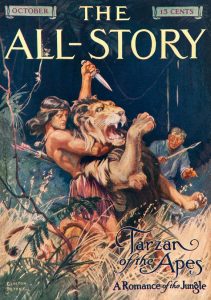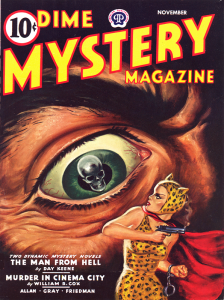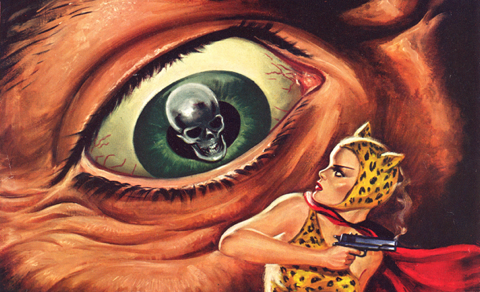So what’s this PulpFest that has so many people talking? With almost 3,000 likes on Facebook and more than 700 followers on Twitter, it certainly has been generating a lot of excitement. But what’s it all about?
 PulpFest is named for pulp magazines — fiction periodicals named after the cheap paper on which they were printed. Frank A. Munsey pioneered the format in 1896 with THE ARGOSY. A decade later, pulps began to pick up steam with titles like BLUE BOOK and ADVENTURE, then exploded in 1912 when THE ALL-STORY printed a little yarn by Edgar Rice Burroughs called “Tarzan of the Apes.” Soon thereafter, genre titles began to flourish, among them DETECTIVE STORY, WESTERN STORY, and LOVE STORY. In the twenties, publishing legends such as BLACK MASK, WEIRD TALES and AMAZING STORIES debuted. The following decade saw the advent of the so-called “hero pulps” with magazines such as THE SHADOW, DOC SAVAGE, and THE SPIDER attracting new readers to the rough-paper format. Weird-menace magazines premiered around the same time with DIME MYSTERY MAGAZINE, SPICY MYSTERY STORIES, and TERROR TALES scaring the wits out of readers. The late thirties saw an explosion of science fiction pulps — led by John W. Campbell’s ASTOUNDING STORIES — with other titles such as FANTASTIC ADVENTURES and PLANET STORIES thrilling readers of all ages.
PulpFest is named for pulp magazines — fiction periodicals named after the cheap paper on which they were printed. Frank A. Munsey pioneered the format in 1896 with THE ARGOSY. A decade later, pulps began to pick up steam with titles like BLUE BOOK and ADVENTURE, then exploded in 1912 when THE ALL-STORY printed a little yarn by Edgar Rice Burroughs called “Tarzan of the Apes.” Soon thereafter, genre titles began to flourish, among them DETECTIVE STORY, WESTERN STORY, and LOVE STORY. In the twenties, publishing legends such as BLACK MASK, WEIRD TALES and AMAZING STORIES debuted. The following decade saw the advent of the so-called “hero pulps” with magazines such as THE SHADOW, DOC SAVAGE, and THE SPIDER attracting new readers to the rough-paper format. Weird-menace magazines premiered around the same time with DIME MYSTERY MAGAZINE, SPICY MYSTERY STORIES, and TERROR TALES scaring the wits out of readers. The late thirties saw an explosion of science fiction pulps — led by John W. Campbell’s ASTOUNDING STORIES — with other titles such as FANTASTIC ADVENTURES and PLANET STORIES thrilling readers of all ages.
By the early fifties, the pulps were gone, killed by competition from paperback books, comic books, radio, television, and movies. But the fiction and artwork that appeared in the rough-paper consumables of the early twentieth century kept them alive in the hearts and minds of countless individuals. Haunting back-issue magazine shops, flea markets, science fiction conventions, and other venues, these hearty souls gradually assembled astounding collections of genre fiction, all published in the rough and ragged magazines known as pulps. Eventually, these collectors organized a convention dedicated to the premise that the pulps had a profound effect on American popular culture that reverberated through a wide variety of mediums — comic books, movies, paperbacks and genre fiction, television, men’s adventure magazines, radio drama, and even video and role-playing games. Today, we call this convention, PulpFest.
The summertime destination for fans and collectors of vintage popular fiction and related materials, PulpFest seeks to honor the pulps by drawing attention to the many ways these throwaway articles have inspired writers, artists, film directors, software developers, and other creators over the decades.
 Why not come see what it’s all about? PulpFest 2017 will be paying tribute to the hardboiled dicks, dangerous dames, and a few psychos of the pulps. We’ll be exploring DIME DETECTIVE MAGAZINE — where the hard-boiled detective story developed into an important fiction genre — and Robert Leslie Bellem’s tough-guy detective, Dan Turner; Pat Savage, The Domino Lady, and other dangerous dames of the pulps, the hardboiled ladies who helped pave the way for such modern day gumshoes as Sue Grafton‘s Kinsey Millhone, Marcia Muller‘s Sharon McCone, and Sara Paretsky‘s V. I. Warshawski; and some of the mad scientists, crazed hunchbacks, and foul cultists who decimated American cities on a monthly basis in rough-paper magazines like THE SHADOW. We’ll also be saluting the hundredth anniversary of the birth of Robert Bloch, the author of PSYCHO — later adapted to film by Alfred Hitchcock. Bloch got his start as a writing professional in the pulps.
Why not come see what it’s all about? PulpFest 2017 will be paying tribute to the hardboiled dicks, dangerous dames, and a few psychos of the pulps. We’ll be exploring DIME DETECTIVE MAGAZINE — where the hard-boiled detective story developed into an important fiction genre — and Robert Leslie Bellem’s tough-guy detective, Dan Turner; Pat Savage, The Domino Lady, and other dangerous dames of the pulps, the hardboiled ladies who helped pave the way for such modern day gumshoes as Sue Grafton‘s Kinsey Millhone, Marcia Muller‘s Sharon McCone, and Sara Paretsky‘s V. I. Warshawski; and some of the mad scientists, crazed hunchbacks, and foul cultists who decimated American cities on a monthly basis in rough-paper magazines like THE SHADOW. We’ll also be saluting the hundredth anniversary of the birth of Robert Bloch, the author of PSYCHO — later adapted to film by Alfred Hitchcock. Bloch got his start as a writing professional in the pulps.
The convention’s guest of honor will be Pittsburgh artist Gloria Stoll Karn. In a field dominated by men, it was highly unusual for a woman to be painting covers for pulp magazines. But at age seventeen, Gloria Stoll began contributing black and white interior illustrations to pulp magazines. In a few years, the young artist was painting covers. How’s that for a dangerous dame? One of the few surviving contributors to the pulp magazine industry, Ms. Stoll Karn will be joined by pulp art historian David Saunders — winner of our 2016 Lamont Award — to discuss her freelance career in the pulps and much more on Saturday evening, July 29.
We’ll have all this plus a dealers’ room featuring tens of thousands of pulp magazines, vintage paperbacks, digests, men’s adventure and true crime magazines, original art, first edition hardcovers, series books, reference books, dime novels and story papers, Big Little Books, B-Movies, serials and related paper collectibles, old-time radio shows, and Golden and Silver Age comic books, as well as newspaper adventure strips. For a look at our planned schedule, please visit our home page and click the Programming for 2017 button just below our banner.
The convention will take place from Thursday evening, July 27, through Sunday afternoon, July 30, at the DoubleTree by Hilton Hotel Pittsburgh – Cranberry, just nineteen miles north of the exciting city of Pittsburgh. You can book your room directly through the PulpFest website. Just click the “Book a Room for 2017” link on our home page or call 1-800-222-8733. Be sure to mention PulpFest in order to receive the convention rate.
Start making your plans now to join in our exploration of “Hardboiled Dicks, Dangerous Dames, and a Few Psychos” at the “pop culture center of the universe” called PulpFest 2017.
(Published by the Frank A. Munsey Company, the October 1912 issue of THE ALL-STORY featured Edgar Rice Burroughs’ novel “Tarzan of the Apes,” published in its entirety. Clinton Pettee — who illustrated many of the Munsey magazines as well as the pulp, SHORT STORIES — painted the front cover art for the magazine. Burroughs’ Tarzan is perhaps the most famous character to emerge from the pulps.
Over thirty years after the publication of “Tarzan of the Apes,” a young Gloria Stoll Karn contributed the cover art for the November 1943 issue of Popular Publications’ DIME MYSTERY MAGAZINE. The artist would paint more than 100 covers for the pulps of the 1940s.)







